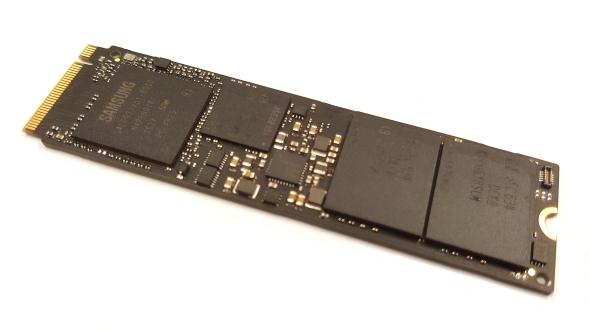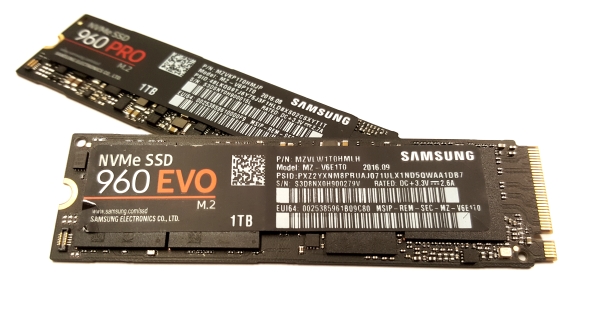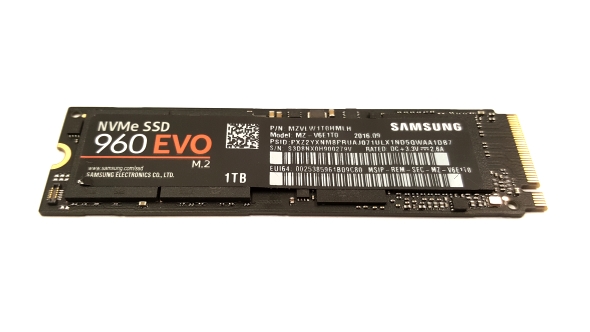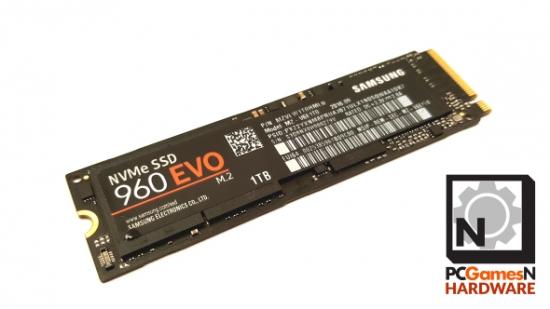You can pretty much forget the ol’ SATA storage interface now. Purge it from your memory, we don’t need it anymore. Your primitive SSD and spinning platter anachronisms can be recycled because Samsung have created a range of drives which offer large amounts of storage at a great price and with almost unprecedented speed.
Want a CPU that can keep up with your SSD? Take your pick from our choice of the best CPU for gaming.
I say almost unprecedented because they’ve already released the fastest consumer SSD around with their 960 Pro drives. But with the 960 EVO version Samsung have taken a more budget-oriented approach, yet still managed to put together a PCIe SSD that’s faster than pretty much anything else out there bar it’s own big brother.
Both Samsung drives are based on the PCIe interface, with the modern NVMe protocol, and run from the M.2 motherboard slot. And that means there’s no slow-poke SATA anywhere near these new drives. Okay, it’s maybe jumping the gun to call time on the SATA interface – you can get seriously cheap, high-capacity SATA SSDs which make for great data drives – but we’re at a stage where the M.2 slot can deliver a powerful mix of high-capacity, lightning speed and now, with the 960 EVO, great value.
Feel a desperate need to skip the specs and dive straight to the performance and verdict sections? Click on the jump links below if you have to…
Samsung 960 EVO 1TB specs

So how have Samsung created such a mini marvel? The key spec to the 960 EVO is the choice of V-NAND (Samsung’s proprietary stacked memory tech) flash memory they’ve used to fill out the drive’s various capacities. The 960 EVO is available in either 250GB, 500GB or 1TB flavours and Samsung have used their own 3-bit MLC (otherwise known as TLC) stacked NAND to get to that size.
The use of TLC means Samsung can charge $480 (£440) for the 1TB version of the 960 EVO, with the 500GB option at $250 (£230). Compared with the $629 (£629) price tag of the 1TB Pro drive that’s quite a difference and at just 48c (44p) per gigabyte even this 1TB drive is pretty good value.
The more expensive 960 Pro uses 2-bit MLC NAND which has a higher endurance rating, runs quicker and isn’t quite so power-hungry as the cheaper TLC memory. Hence why that is used for the top-end drive and why Samsung have typically opted for TLC with their lower cost EVO drives.
Somewhat miraculously there are just two V-NAND chips on the 1TB 960 EVO. That’s 512GB of storage on just two little chips and I still find it pretty incredible you can squeeze so much storage space onto just a pair of silicon slabs. Elsewhere on the sparse SSD board are the Polaris memory controller and the little 1GB DDR3 DRAM cache chip. It’s that five-core Polaris memory controller which enables even the cheaper TLC V-NAND to post such high levels of storage performance. It’s also what’s responsible for keeping the EVO’s thermal levels in check. SSDs can run incredibly hot and because of TLC’s higher energy draw the high-speed 960 EVO especially needs that to be managed.
Like everything else on the 960 EVO, Samsung have created the Polaris memory controller completely in-house. It’s this process which means Samsung pretty much dominates the SSD world right now, in terms of both price and pace. Having complete dominion over their SSD technology means they can get incredibly aggressive on both.
Samsung have also created a new version of their TurboWrite caching technology for the 960 SSDs. It’s essentially a write buffer which apportions a small amount of the MLC V-NAND to be used as faster SLC (single layer cell) memory, speeding up performance. The 1TB version has a 6GB TurboWrite buffer as default while the 250GB and 500GB versions have 4GB each. What that traditionally means is that, so long as the amount of data being transferred in a single transaction is below that number, it will run at SLC speeds, but if it’s higher it will revert back to ordinary TLC performance.
Samsung have now created a dynamic version for the EVO which allows the drive to steal back some unused storage space to add to the TurboWrite cache if required to keep performance up. That only works when there is enough spare capacity on the drive, but it’s still a neat workaround the otherwise limited cache size.
One thing that is also worth mentioning here is the warranty. The 960 EVO is only sporting a three year warranty as opposed to the five year one offered with the 960 Pro and previous, SATA-based, 850 EVO. That said, it still has a much higher endurance level than the older drive, with a 400TB rating as opposed to the 1TB 850 EVO’s 150TB level. The 1TB 960 Pro, by contrast, has double the endurance levels of the 1TB 960 EVO.
Samsung 960 EVO 1TB benchmarks
Samsung 960 EVO 1TB performance

Both the 960 EVO and Pro 1TB drives comfortably top our SSD performance chart. They’re clearly quicker than even Intel’s mighty SSD 750 in 1.2TB trim. And, given the price delta between the two Samsung drives, the fact there really isn’t much between them in straight sequential performance in quite something to behold.
To be measuring a drive which costs just 48c (44p) per gigabyte in GB/s is a marvellous expression of just how far SSDs have come. We used to get excited when they dropped below $1 (£1) per gigabyte and giddy beyond words if they topped 500MB/s. Now we’re talking about this affordable option hitting 3.35GB/s read and 1.95GB/s write speeds. The more-demanding AS SSD benchmark does cut those speeds a fair amount, and by a greater margin than the MLC-packing Pro version, but the EVO still manages to keep its nose ahead of the closest Intel rival.
Update: We’ve just re-tested the 960 EVO with Samsung’s latest NVMe driver and the 4k random performance has massively improved, as have the general AS SSD sequential read/write scores. Originally the drive was hitting sub-par 27MB/s and 54MB/s speeds for reads and writes respectively, but is now benchmarking at 49MB/s and 189MB/s. That actually puts it above the 960 Pro in those tests now. It has though also knocked back the sequential ATTO read/write figures a touch, which isn’t so good.
We also went back and benchmarked the 960 Pro in light of this. When we first reviewed the drive Samsung were a month away from releasing their own NVMe drivers so, like our initial 960 EVO tests, we benchmarked it with the stock NVMe drivers.
On the 960 Pro the ATTO results have remained essentially the same, but bizarrely the AS SSD sequential performance has dropped. And what of its 4k random performance? Well, rather random, truth be told. The 4k read performance has dropped to 46MB/s, but the write speeds have risen to 178MB/s. Which still puts it behind the EVO.
Original: Where it’s not looking so rosy though is in the little 4k random read/write performance. These represent the tiny files that your OS is constantly flinging around during use and is a good indicator of how responsive your drive will feel. The relatively poor results on this front from the 960 EVO means it’s not going to feel any different in general desktop use compared with a pretty standard 2.5-inch SATA SSD.
But those are still synthetic tests and with the advanced TurboWrite caching tech the 960 EVO is still able to keep up with both the Pro and the Intel SSD 750 in real-world tests. It’s still lightning quick in our 5GB compression test and isn’t far off when it comes to the chunkier 30GB folder and file transfer.
Samsung 960 EVO 1TB verdict

The Samsung 960 EVO is a stunning little drive. I’m still astounded by the fact Samsung can jam a whole terabyte of storage into just two chips on a single-sided PCB, but it’s not just the scale of the drive which impresses me. The 960 EVO is two-thirds the price of its 960 Pro counterpart and yet is only marginally slower across most of our benchmarks. And it’s still considerably pacier than most other PCIe drives you care to mention.
While the 960 EVO is great value for what it is, you are still paying a high-price for high-end technology. The similarly TLC-based Intel 600p drives are around $120 (£120) cheaper than the Samsung 960 EVO, but then they are also far slower all round too – most especially in the write performance stakes.
You can also pick up 1TB SATA drives for around half the price if space is more important than pace. And that means we’re getting close to the stage where people are going to be using SATA SSDs as their storage drive while opting for NVMe drives as their boot option – a version of the HDD data drive / SSD boot drive combo for this super-fast storage future.
That Samsung have maintained the straight-line SSD performance for their cheaper EVO series is seriously impressive. The 1TB 960 EVO may still be a lot of cash to drop on a drive, but with the 500GB option Samsung are bringing top-end storage performance into a genuinely affordable price point.
